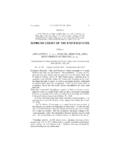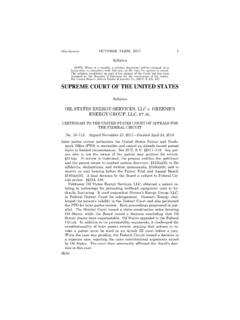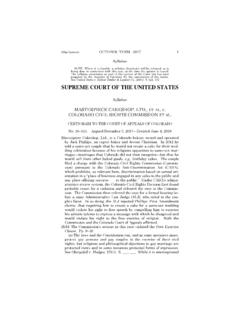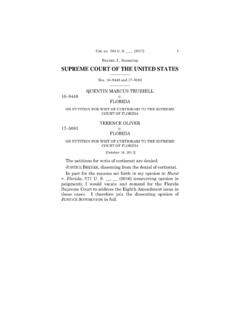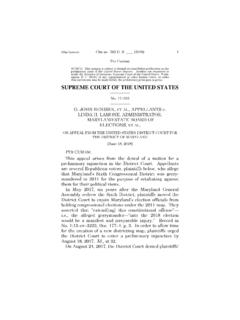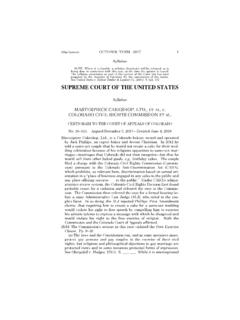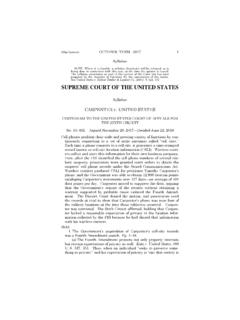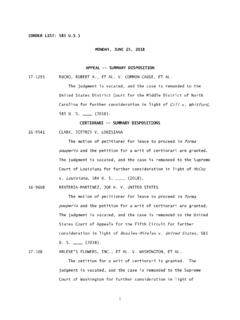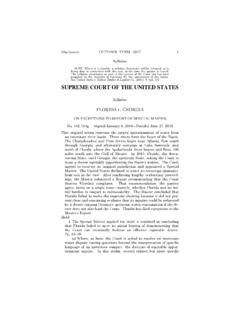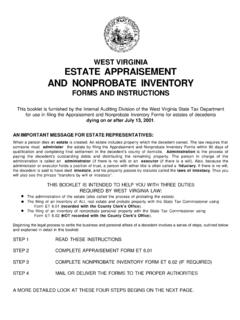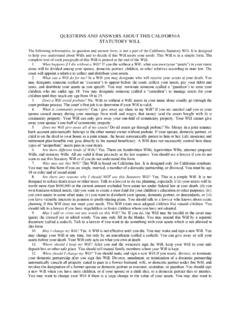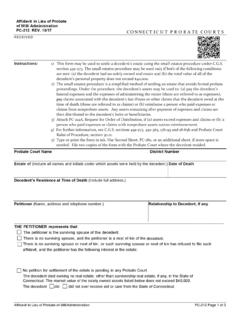Transcription of SUPREME COURT OF THE UNITED STATES
1 1 (Slip Opinion) OCTOBER TERM, 2017 Syllabus NOTE: Where it is feasible, a syllabus (headnote) will be released, as isbeing done in connection with this case, at the time the opinion is syllabus constitutes no part of the opinion of the COURT but has beenprepared by the Reporter of Decisions for the convenience of the reader. See UNITED STATES v. Detroit Timber & Lumber Co., 200 U. S. 321, 337. SUPREME COURT OF THE UNITED STATES Syllabus SVEEN ET AL. v. MELIN CERTIORARI TO THE UNITED STATES COURT OF APPEALS FOR THE EIGHTH CIRCUIT No. 16 1432. Argued March 19, 2018 Decided June 11, 2018 The legal system has long used default rules to resolve estate litigation in a way that conforms to decedents presumed intent. In 2002, Min-nesota enacted a statute establishing one such default rule.
2 The statute provides that the dissolution or annulment of a marriage re-vokes any revocable .. beneficiary designation .. made by an indi-vidual to the individual s former spouse. Minn. Stat. 804, subd. 1. Under the statute, if one spouse has made the other the beneficiary of a life insurance policy or similar asset, their divorce au-tomatically revokes that designation so that the insurance proceedswill instead go to the contingent beneficiary or the policyholder s es-tate upon his death. The law does this on the theory that the policy-holder would want that result. But if he does not, he may rename the ex-spouse as beneficiary. Mark Sveen and respondent Kaye Melin were married in next year, Sveen purchased a life insurance policy, naming Melin as the primary beneficiary and designating his two children from a prior marriage, petitioners Ashley and Antone Sveen, as contingent beneficiaries.
3 The Sveen-Melin marriage ended in 2007, but the di-vorce decree made no mention of the insurance policy and Sveen took no action to revise his beneficiary designations. After Sveen passedaway in 2011, Melin and the Sveen children made competing claimsto the insurance proceeds. The Sveens argued that under Minneso-ta s revocation-on-divorce law, their father s divorce canceled Melin s beneficiary designation, leaving them as the rightful recipients. Melin claimed that because the law did not exist when the policy waspurchased and she was named as the primary beneficiary, applyingthe later-enacted law to the policy violates the Constitution s Con-tracts Clause. The District COURT awarded the insurance money to 2 SVEEN v.
4 MELIN Syllabus the Sveens, but the Eighth Circuit reversed, holding that the retroac-tive application of Minnesota s law violates the Contracts Clause. Held: The retroactive application of Minnesota s statute does not vio-late the Contracts Clause. That Clause restricts the power of Statesto disrupt contractual arrangements, but it does not prohibit all lawsaffecting pre-existing contracts, see El Paso v. Simmons, 379 U. S. 497, 506 507. The two-step test for determining when such a law crosses the constitutional line first asks whether the state law has operated as a substantial impairment of a contractual relationship. Allied Structural Steel Co. v. Spannaus, 438 U. S. 234, 244. In an-swering that question, the COURT has considered the extent to which the law undermines the contractual bargain, interferes with a party s reasonable expectations, and prevents the party from safeguarding or reinstating his rights.
5 See id., at 246; El Paso, 379 U. S., at 514 515; Texaco, Inc. v. Short, 454 U. S. 516, 531. If such factors show a sub-stantial impairment, the inquiry turns to whether the state law is drawn in an appropriate and reasonable way to advance a signif-icant and legitimate public purpose. Energy Reserves Group, Inc. v. Kansas Power & Light Co., 459 U. S. 400, 411 412. The COURT stops after the first step here, because three aspects of Minnesota s law, taken together, show that the law does not substan-tially impair pre-existing contractual arrangements. First, the law is designed to reflect a policyholder s intent and so to support, rather than impair, the contractual scheme. It applies a prevalent legisla-tive presumption that a divorcee would not want his former partnerto benefit from his life insurance policy and other will the law often honors, not undermines, the intent of the only contracting party to care about the beneficiary term.
6 Second, the law is unlikely to disturb any policyholder s expectations at the time of contracting, because an insured cannot reasonably rely on a benefi-ciary designation staying in place after a divorce. Divorce courts have wide discretion to divide property upon dissolution of a mar-riage, including by revoking spousal beneficiary designations in lifeinsurance policies or by mandating that such designations a life insurance purchaser cannot know what will happen tothat policy in the event of a divorce, his reliance interests are next to nil. And that fact cuts against providing protection under the Con-tracts Clause. Last, the law supplies a mere default rule, which the policyholder can undo in a moment. If the law s presumption aboutwhat an insured wants after divorcing is wrong, the insured mayoverthrow it simply by sending a change-of-beneficiary form to his in-surer.
7 This COURT has long held that laws imposing such minimal paper-work burdens do not violate the Contracts Clause. It has repeatedly 3 Cite as: 584 U. S. ____ (2018) Syllabus sustained so-called recording statutes, which extinguish contractual interests unless timely recorded at government offices. See Jackson v. Lamphire, 3 Pet. 280; Vance v. Vance, 108 U. S. 514; Texaco, Inc. v. Short, 454 U. S. 516. The COURT has also upheld laws mandatingother kinds of notifications or filings against Contracts Clause attack. See Curtis v. Whitney, 13 Wall. 68; Gilfillan v. Union Canal Co. of Pa., 109 U. S. 401; Conley v. Barton, 260 U. S. 677. The Minnesota law places no greater obligation on a contracting party than these laws while imposing a lesser penalty for noncompliance.
8 Filing achange-of-beneficiary form is as easy as satisfying the paperwork re-quirements that this COURT s prior cases approved. And if an insured wants his ex-spouse to stay as beneficiary but does not send in hisform, the result is only that the insurance money is redirected to his contingent beneficiaries, not that his contractual rights are extin-guished. Pp. 6 14. 853 F. 3d 410, reversed and remanded. KAGAN, J., delivered the opinion of the COURT , in which ROBERTS, C. J., and KENNEDY, THOMAS, GINSBURG, BREYER, ALITO, and SOTOMAYOR, JJ., joined. GORSUCH, J., filed a dissenting opinion. _____ _____ 1 Cite as: 584 U. S. ____ (2018) Opinion of the COURT NOTICE: This opinion is subject to formal revision before publication in thepreliminary print of the UNITED STATES Reports. Readers are requested tonotify the Reporter of Decisions, SUPREME COURT of the UNITED STATES , Wash-ington, D.
9 C. 20543, of any typographical or other formal errors, in orderthat corrections may be made before the preliminary print goes to press. SUPREME COURT OF THE UNITED STATES No. 16 1432 ASHLEY SVEEN, ET AL., PETITIONERS v. KAYE MELIN ON WRIT OF CERTIORARI TO THE UNITED STATES COURT OF APPEALS FOR THE EIGHTH CIRCUIT [June 11, 2018] JUSTICE KAGAN delivered the opinion of the COURT . A Minnesota law provides that the dissolution or an-nulment of a marriage revokes any revocable[] beneficiary designation[] made by an individual to the individual s former spouse. Minn. Stat. 804, subd. 1 (2016). That statute establishes a default rule for use when Min-nesotans divorce. If one spouse has made the other the beneficiary of a life insurance policy or similar asset, their divorce automatically revokes that designation on thetheory that the policyholder would want that result.
10 But if he does not, the policyholder may rename the ex-spouseas consider here whether applying Minnesota s automatic-revocation rule to a beneficiary designation made before the statute s enactment violates the Contracts Clause of the Constitution. We hold it does not. I All good trust-and-estate lawyers know that [d]eath is not the end; there remains the litigation over the estate. 8 The Collected Works of Ambrose Bierce 365 (1911).That epigram, beyond presaging this case, helps explain the statute at its center. 2 SVEEN v. MELIN Opinion of the COURT The legal system has long used default rules to resolveestate litigation in a way that conforms to decedents presumed intent. At common law, for example, marriage automatically revoked a woman s prior will, while mar-riage and the birth of a child revoked a man s.
